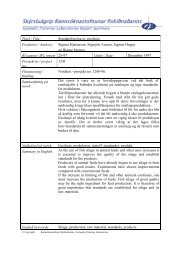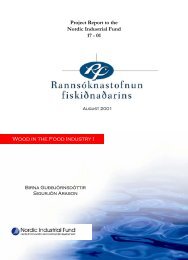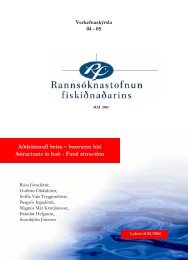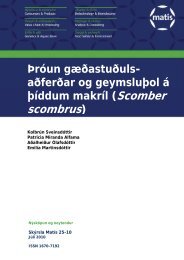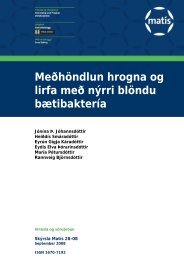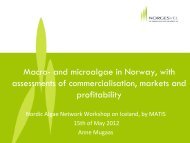Microbiology and Spoilage Trail in Nile Perch (Lates niloticus), Lake ...
Microbiology and Spoilage Trail in Nile Perch (Lates niloticus), Lake ...
Microbiology and Spoilage Trail in Nile Perch (Lates niloticus), Lake ...
You also want an ePaper? Increase the reach of your titles
YUMPU automatically turns print PDFs into web optimized ePapers that Google loves.
the components contribut<strong>in</strong>g to TVB-N content. The value of TVB-N at which <strong>Nile</strong> perch is<br />
unacceptable is not well established, Karungi et al., (2004).<br />
The change/shift <strong>in</strong> pH units was constant (7.01-7.11) throughout storage time <strong>in</strong> ice. This<br />
was higher than the pH reported by Gram et al., (1989) which was 6.7-6.8 units but same<br />
small shift dur<strong>in</strong>g storage i.e. with<strong>in</strong> 0.1 units. Constant small shift has also been reported<br />
on ra<strong>in</strong>bow trout (Chytiri et al., 2004) <strong>and</strong> European sea bass, (Castro et al., 2006).<br />
5.2.2 Phase II trial 2: Shelf life of laboratory chilled fillets<br />
5.2.2.1 Microbiological analysis<br />
Storage time of Laboratory chilled <strong>Nile</strong> perch stored at 0-3 o C was between 17-23 days.<br />
Shelf life for good quality on freshness chilled fillets was 17 storage days. The average<br />
counts for both SSO <strong>and</strong> TVC were between 6-8 log10 cfu/g. Study on chilled <strong>Nile</strong> perch<br />
fillets stored at 0 o C by Gram et al., (1989) found total viable counts of 5 x 10 7 cfu/g <strong>and</strong><br />
SSO counts of 10 4 -10 5 cfu/g at the end of storage time (3 weeks). In the same study on<br />
contam<strong>in</strong>ated fillets with Pseudomonas, the SSO counts were 10 8 -10 9 cfu/g <strong>in</strong> 10 days of<br />
storage time <strong>and</strong> rema<strong>in</strong>ed constant for the rest of storage time which is <strong>in</strong> agreement with<br />
the present study. In this study the counts were stable from 20-23 days of storage. Counts of<br />
Enterobacteriaceae were constant around 4 log10 cfu/g dur<strong>in</strong>g the first 17 days of storage<br />
but then <strong>in</strong>creased to a stable 8 log10 cfu/g at day 18 until end of storage time. The growth<br />
rate of Enterobacteriaceae may be slower at low temperatures (0-3 o C) than that of other<br />
Gram-negative psychrotrophic spoilers (Chytiri et al., 2004). Mesophilic organisms like<br />
Enterobacteriaecea; require condition<strong>in</strong>g dur<strong>in</strong>g chill storage temperature before they can<br />
grow <strong>in</strong> big numbers. On the basis of this study Enterobacteriaceae may be considered as a<br />
part of the spoilage micro flora <strong>in</strong> chilled <strong>Nile</strong> perch fillets. Likewise, Hozbor et al., (2006)<br />
<strong>and</strong> Fonnesbech et al., (2005) reported Enterobacteriaceae <strong>in</strong> fresh salmon ice at aerobic<br />
storage conditions.<br />
62




